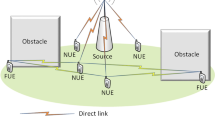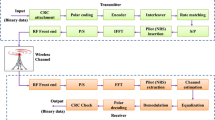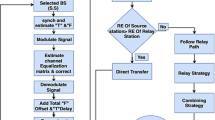Abstract
To exploit the effect of modulation schemes on the best relay selection, a novel Jointing Modulation schemes max-min criterion (JM-max-min) is proposed firstly for Two-Way De-Noise-and-Forward (DNF) Opportunistic Relaying systems (TW-DNF-OR) by aiming at minimizing the Pairwise Error Probability (PEP) of Multi-Access (MA) phase which dominates the error performance of TW-DNF-OR due to the presence of MA interference. The proposed JM-max-min criterion integrates perfectly the minimum distances of constellations and the relay links gains. Then, with the proposed JM-max-min criterion, we analyze the Symbol Error Probabilities (SEPs) of MA phase and BroadCast (BC) phase by using the approximated mathematics analysis, and present the corresponding closed-form expressions to SEPs. The numerical analysis shows, for a given modulations combination at both sources, the TW-DNF-OR systems with the proposed JM-max-min criterion outperform the one with the conventional max-min criterion.
Similar content being viewed by others
Reference
X. D. Jia and H. Y. Fu. Research on the outage exponent of superposition coding relaying with only relay-to-source channel state feedback. Chinese Journal of Electronics, 20(2011)1, 161–164.
X. D. Jia, H. Y. Fu, and L. X. Yang, et al. Superposition coding cooperative relaying communications: outage performance analysis. International Journal of Communication Systems, 24(2011)3, 364–397.
X. D. Jia and L. X Yang. Diversity-and-multiplexing tradeoff and throughput of superposition coding relaying strategy. Journal of Electronics (China), 27 (2010)2, 166–175.
R. Ahlswede, et al. Network information flow. IEEE Transactions on Information Theory, 46(2000)4, 1204–1216.
S. Y. R. Li, R. W. Yeung, and C. Ning. Linear network coding. IEEE Transactions on Information Theory, 49(2003)2, 371–381.
R. Koetter and M. Medard. Beyond routing: an algebraic approach to network coding. IEEE/ACM Transactions on Networking, 11(2003)5, 122–130.
S. Katti, et al. XORs in the Air: Practical wireless network coding. IEEE/ACM Transactions on Networking, 16(2008)3, 497–510.
E. S. Lo and K. B. Letaief. Network coding versus superposition coding for two-way wireless communication. Proceedings of 2009 IEEE Wireless Communications and Networking Conference, WCNC’2009, Budapest, Hungary, 2009, 1–5.
P. Popovski and H. Yomo. Wireless network coding by amplify-and-forward for bi-directional traffic flows. IEEE Communications Letters, 11(2007)1, 16–18.
R. Zhang and L. Hanzo. Physical-layer algebraic network coding and superposition coding for the multi-source cooperation aided uplink. Proceedings of 2009 IEEE Vehicular Technology Conference, Barcelona, Spain, 2009, 1–5.
T. Koike-Akino, P. Popovski, and V. Tarokh. Optimized constellations for two-way wireless relaying with physical NC. IEEE Journal on Selected Areas in Communications, 27(2009)5, 773–787.
J. H. Sorensen, et al. Physical layer network coding for FSK systems. IEEE Communications Letters, 13 (2009)8, 597–599.
P. Popovski and H. Yomo. Bi-directional amplification of throughput in a wireless multi-hop network. Proceedings of 2006 IEEE Vehicular Technology Conference, VTC 2006-spring, Melbourne, Australia, 2006, 588–593.
P. Popovski and H. Yomo. The anti-packets can increase the achievable throughput of a wireless multi-hop network. Proceedings of 2006 IEEE International Conference on Communications, ICC’06, Istanbul, Turkey, 2006, 3885–3890.
L. Anxin, Y. Yuan, and H. Kayama. An enhanced denoise-and-forward relaying scheme for fading channel with low computational complexity. IEEE Signal Processing Letters, 15(2008), 857–860.
J. H. Sorensen, R. Krigslund, and P. Popovski, et al. Scalable denoise-and-forward in bidirectional relay networks. Computer Networks, 54(2010)10, 1607–1614.
T. Koike-Akino, P. Popovski, and V. Tarokh. Adaptive modulation and network coding with optimized precoding in two-way relaying. Proceedings of 2009 IEEE Global Telecommunications Conference, GLOBECOM’2009, Honolulu, HI, USA, 2009, 1–6.
A. Bletsas, A. Khisti, D. P. Reed, et al. A simple cooperative diversity method based on network path selection. IEEE Journal on Selected Areas in Communications, 24(2006)3, 659–72.
Jiangbo Si, Zan Li, and Zengji Liu. Outage probability of opportunistic relaying in rayleigh fading channels with multiple interferers. IEEE Signal Processing Letters, 17(2010)5, 445–448.
H. A. Suraweera, M. Soysa, C. Tellambura, et al. Performance analysis of partial relay selection with feedback delay. IEEE Signal Processing Letters, 17 (2010)6, 531–534.
M. Torabi, D. Haccoun, and W. Ajib. Performance analysis of cooperative diversity with relay selection over non-identically distributed links. IET Communications, 4(2010)5, 596–605.
J. L. Vicario, A. Bel, J. A. Lopez-Salcedo, et al. Opportunistic relay selection with outdated CSI: Outage probability and diversity analysis. IEEE Transactions on Wireless Communications, 8(2009)6, 2872–2876.
Weifeng Su and Xin Liu. On optimum selection relaying protocols in cooperative wireless networks. IEEE Transactions on Communications, 58(2010)1, 52–57.
N. Yang, M. Elkashlan, and J. Yuan. Outage probability of multiuser relay networks in Nakagami- m fading channels. IEEE Transactions on Vehicular Technology, 59(2010)5, 2120–2132.
T. J. Oechtering and H. Boche. Bidirectional regenerative half-duplex relaying using relay selection. IEEE Transactions on Wireless Communications, 7(2008)5, 1879–1888.
I. Krikidis. Relay selection for two-way relay channels with MABC DF: A diversity perspective. IEEE Transactions on Vehicular Technology, 59(2010)9, 4620–4628.
K. S. Hwang, Y. C. Ko, and M. S. Alouini. Performance bounds for two-way amplify-and-forward relaying based on relay path selection. Proceedings of 2009 IEEE Vehicular Technology Conference, VTC Spring 2009, Barcelona, Spain, 2009, 1–5.
J. Zheng, B. Bai, and Y. Li. Outage-optimal opportunistic relaying for two-way amplify and forward relay channel. Electronics Letters, 46(2010)8, 595–597.
H. Guo and J. H. Ge. Outage probability of two-way opportunistic amplify-and-forward relaying. Electronics Letters, 46(2010)13, 918–919.
M. Ju and I. M. Kim. Relay selection with analog network coding in bidirectional networks. Proceedings of 2010 25th Biennial Symposium on Communications (QBSC), Kingston, Ontario, Canada, 2010, 293–96.
M. Ju and I. M. Kim. Relay selection with ANC and TDBC protocols in bidirectional relay networks. IEEE Transactions on Communications, 58(2010)12, 3500–3511.
H. Ding, J. Ge, D. B. da Costa, et al. Outage performance of fixed-gain bidirectional opportunistic relaying in Nakagami-m fading. Electronics Letters, 46(2010)18, 1297–1299.
Y. H. Li, R. H. Y. Louie, and B. Vucetic. Relay selection with network coding in two-way relay channels. IEEE Transactions on Vehicular Technology, 59(2010)9, 4489–4499.
Q. F. Zhou, Y. H. Li, F. C. M. Lau, et al. Decode- and-forward two-way relaying with NC and opportunistic relay selection. IEEE Transactions on Communications, 58(2010)11, 3070–3076.
Z. Chen, H. Liu, and W. Wang. A novel decoding- and-forward scheme with joint modulation for two-way relay channel. IEEE Communications Letters, 14(2010)12, 1149–1151.
S. S. Ikki and M. H. Ahmed. On the performance of cooperative-diversity networks with the Nth best-relay selection scheme. IEEE Transactions on Communications, 58(2010)11, 3062–3069.
T. Cui, F. F. Gao, T. Ho, et al. Distributed space-time coding for two-way wireless relay networks. IEEE Transactions on Signal Processing, 57(2009)2, 658–671.
H. A. David and H. N. Nagaraja. Order Statistics. 3rd ed., New York, John Wiley, 2003, 10–19.
Author information
Authors and Affiliations
Corresponding author
Additional information
Supported by the National Natural Science Foundations of China (No. 61071090, No. 61171093), the Postgraduate Innovation Programs of Scientific Research of Jiangsu Province (CX10B-184Z, CXZZ11_0388), and the Project 11KJA510001 and PAPD.
Communication author: Yang Longxiang, born in 1966, male, Ph.D., Professor.
About this article
Cite this article
Jia, X., Yang, L. & Shao, S. Two-way denoise-and-forward network coding opportunistic relaying aiming at minimizing euclidean distance in multi-access phase. J. Electron.(China) 28, 433–443 (2011). https://doi.org/10.1007/s11767-012-0750-x
Received:
Revised:
Published:
Issue Date:
DOI: https://doi.org/10.1007/s11767-012-0750-x




